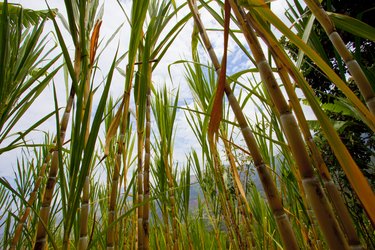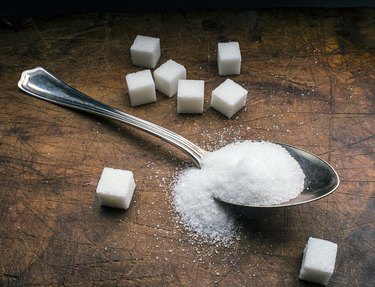
"Sugar is sugar," explained the tour director from Clewiston, Florida's U.S. Sugar Company as we ventured through the cane fields of Belle Glade and Clewiston trying to unveil the mystery of sugar production. In the wintertime, the air in Palm Beach County has a sweet fragrance, and the skies are darkened with the ash from sugar burning in the fields as the sugar crop is harvested. Florida produces over 50 percent of the nation's sugar, with Palm Beach County accounting for 75 percent of that total. But white sugar isn't the only product the stately sugarcanes produce. Byproducts of sugarcane have created an industry of their own.
Products From Sugar
Video of the Day
The bags of sugar in the grocery aisles all contain the same ingredient regardless of the manufacturer's labels. All sugar comes from processors rending the white gold into the same product – it's the distributors that name and price the product differently. Whether you purchase your bag of sugar at a discount store or a gourmet grocery, the contents are the same. You'll find regular sugar and finely ground sugar used for baking in the stores and nearby are the bags of specially-processed sugar. This is where the manufacturers differ in their treatment of the sugarcane, creating additional byproducts.
Video of the Day
Beet sugar and cane sugar have the same chemistry and quality, with beet sugar grown in temperate areas and cane sugar a product of the tropics. Cane sugar's byproducts include granulated sugar and liquid sugar, molasses, bagasse, ethanol and farm feed. Advances in technology have found that almost 100 percent of the sugar's cane can be used in a byproduct.
Bagasse From Sugarcane
Recently, a new product has originated from the sugarcane fields – paper plates and cutlery. The demand for products made from fiber has led the sugar industry to examine pulp products; sugarcane pulp, also known as bagasse, was determined to be a viable source. The leftovers from sugarcane processing have the strength of wood and can be processed in a shorter time than wood. Mills producing everything from newsprint to higher quality paper use bagasse, as do manufacturers of dinnerware.

Using bagasse for paper products results in less harvesting of wooded forests while reclaiming the waste from processed sugar. And when you are finished with your disposable paper plates, bowls and utensils, they can be added to your compost pile instead of a landfill, furthering the benefits of byproducts of sugarcane.
Sugarcane as a Feed Source
In locations where grasses are less than optimal for use as animal feed, sugarcane is a feed source in tropical and subtropical climates. A deep-dive into the research needed to convert sugarcane into animal feed is necessary, as the quality depends on crop yield, the nutritive value of the sugarcane, and how easy it is to harvest. Organic and mineral-strong soils produce different qualities of sugarcane. Sugarcane grown for sugar results in the best products for animal feed use, as sucrose is highly digestible.
The age of the sugarcane also contributes to its use as animal feed. As the cane matures, it becomes more digestible. The cycle for sugarcane is such that harvesting during the drier and cooler seasons is optimal. And the cycle for grasses follows suit, leaving cattle dependent on a food source other than pasture forage during the cooler seasons.
Sugarcane to Ethanol Process

As sugarcane is processed, one of the leftovers is ethanol, an alcohol-based fuel, the result of fermentation. Ethanol is a clean, low-carbon biofuel that is an affordable renewable fuel used in the transportation industry. It is used pure or blended with gasoline to contribute to the reduction of pollutants in the air and to provide a clean exhaust. It also reduces greenhouse gasses and reduces dependence on fossil fuels. Brazil, with its high sugarcane production, is the largest producer of ethanol.
Pure ethanol is used in engines that require "flex-fuel" or in engines that are adapted for the use of the sugarcane byproduct. The aviation industry is currently exploring using sugarcane ethanol in the manufacture of ethanol in its aim to reduce its carbon emissions, especially for international flights.
- Florida Farm Family: Farm Facts: Florida Sugar Cane
- University of Florida Institute of Food and Agricultural Sciences: An Overview of Florida Sugarcane
- The Sugar Associaton: Sugar Uses
- PulpandPaper Technology: Innovation of Bagasse
- Ecoproducts: Sugarcane
- University of Florida Extension: Sugarcane as a Cattle Feed
- Sugarcane.org: Sugarcane Products: Ethanol